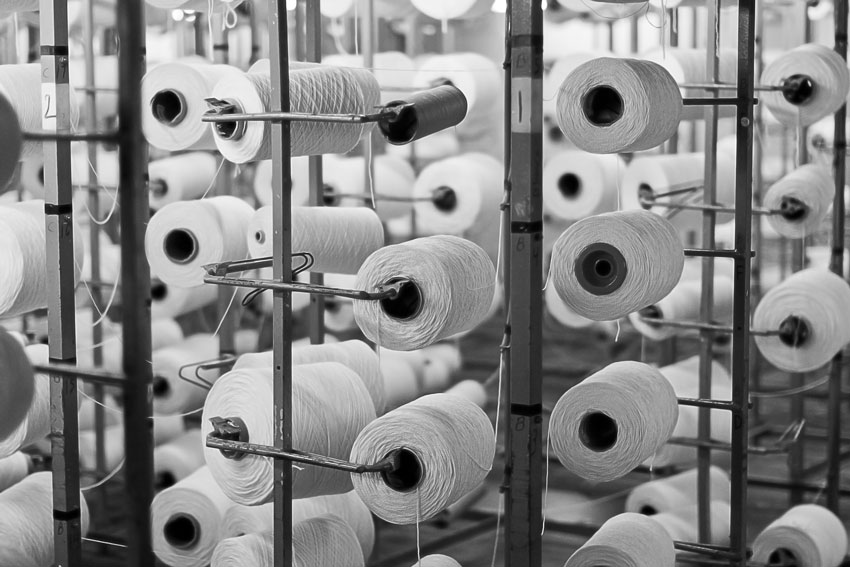Sustainability and the Textile Industry
How Thoughtful Design and Material Specification Can Promote Sustainability
A key concept in sustainability is cradle-to-cradle (C2C) design. C2C is a product design approach modeled on nature’s processes.12 That is, in nature, living things are created, and then work through a life cycle that ends in nurturing new growth. In manufacturing, this approach lends itself to sustainability in the sense that production considers future generations. An underlying premise of this approach is that producing less—and thus disposing of less—is an excellent way to reduce the overall environmental impact of a venture. This way of thinking can be used in various aspects of design and material specification, including resource conservation during construction, resource conservation during occupation, and extended durability for longer life cycles.
Resource Conservation During Construction
Building professionals can promote sustainability during the construction phase of a project in different ways. For example, they can use recovered materials or specify green products from the start of the project. Waste materials also can be reused on site or recycled rather than disposed of. This tactic helps prevent pollution through an organized job site and ensure that waste is turned into something useful.13
Depending on the project, architects and builders can design and specify for sustainability by either reusing or recycling materials from other projects, whether through recovered bricks, windows, doors, or decorative trim. By deconstructing and reusing existing materials, architects can keep project cost down while making positive environmental and social impacts.
In cases where new materials are required, building professionals can go green. This may mean any number of things, from sourcing materials made with recycled content to materials known to have minimal toxic materials. Building materials, such as plastic lumber products or roofing material made from recycled materials, can be used to replace traditional materials, as can siding made from recycled content. Products made from recycled content are also excellent for interiors, whether that includes salvaged wood floors and trim, or carpets and cushioning made from recycled or eco-friendly materials.
Through the construction process, contractors deliberately can design a system to reduce and recycle material waste. For example, designated on-site bins for recyclable materials and non-recyclable materials can be set up ahead of time and sorted throughout the construction process. While this step may at first seem to be just one extra thing to deal with on a job site, it can make an impact on resource conservation.
Resource Conservation During Occupation
Building occupants also can play a role in sustainability through resource conservation, both through reduced energy consumption and reduced water consumption. Both can be achieved through thoughtful building design but also through effective operational practices within the building. For example, residential and commercial occupants can benefit from smart meters, which track energy use and help occupants become more aware of their energy consumption during peak hours.
Buildings that are deliberately designed for energy efficiency may include more windows for daylighting, which can provide occupants with more access to natural light in place of artificial light. Other strategies such as building and window orientation can help naturally heat and cool the building during different times of the year. Choices in siding also can insulate the building from hot and cold extremes, thus normalizing energy use in the course of the year.
Occupants can reduce water consumption by choosing products that limit water use, such as energy saving showerheads and low-water use appliances. Smart-meter devices also can help with energy conservation.
Extended Durability for Longer Life Cycles
When thoughtful design and material specifications are part of the building process, the result can be projects that are durable and that have relatively long life cycles, all while providing a comfortable, healthy, and affordable option for occupants. Projects that are designed with sustainability in mind often have an underlying goal of using materials that can be repaired or upgraded rather than replaced. This tactic may require the manufacturer to shift their thinking and priorities about product design and use. For example, if we look at something like commercial carpet used in an office building, there inevitably will be sections that get worn out more quickly than others, such as in higher traffic areas. An unsustainable product carpet design may include large, continuous pieces of carpet that need to be replaced in five to seven years after being installed, all because 20 percent of the material has been worn out. If the carpet goes into the landfill, that means that roughly 80 percent of good material is thrown away.9
Two more sustainable options could be to use modular carpet tiles in place of larger wall-to-wall carpeting, and to use carpets made from material that either can be recycled or is biodegradable. If modular carpets are used, the sections worn away in high-traffic areas can easily be replaced without removing the entire carpet. And when reusable, recyclable, or biodegradable materials are used, the negative environmental end-of-life impact can be minimized.
Manufacturers can benefit considerably from planning for a product’s end of life and from looking at how certain production decisions can impact energy use, the environment, and even a building’s lifetime energy consumption.
How Textile and Carpet Specification Can Be an Important Part of Creating a Sustainable Project
Textiles are one of the most widely used materials in the world, and the industry is one of the most important economic sectors. Whether used for clothing, vehicle interiors, dwellings, or interior design, textiles can be found in many different forms. When used for interior design, such as carpeting, they can impact the mood of a space both visually and acoustically and even help insulate the interior space.

The textile industry can significantly impact sustainable goals because of the wide range of resources used and new materials now available.
As with architecture and other sectors, the textile and carpet industry has shifted to become more sustainable. Manufacturers who embrace sustainability have implemented strategies that aim not only to conserve resources and improve energy efficiency during manufacturing, but they have worked to help make sure the materials used in the carpets easily can be recycled or reused, and do not off-gas VOCs or toxic chemicals while in use or after disposal. As it is, the issue of carpet disposal is a tricky one. Not only are carpets heavy and bulky, but synthetic carpets are not biodegradable, so when they end up in landfills, the material stays around for a long time. Consequently, new sustainable design strategies are increasingly becoming a priority in the carpet and textile industry.
Because of the extensive nature of the textile supply chain—and the many places where the environment may be impacted—there are countless ways that manufacturers can help textiles and carpet be more sustainably developed. For example, some companies focus on processes that minimize the impact of the dyes on the local environment, while others focus on using materials that easily can be repurposed or recycled. These and other tactics help make overall projects more sustainable. Thoughtful textile selection also helps projects earn LEED v4 credits. Credits may be earned for resource reuse, low-emitting materials for systems furniture and seating, and other methods.14
If we take cotton fiber production as an example, we get a better sense of just how extensive the environmental impact can be. It’s estimated that cotton makes up half of the fiber used for clothing and other textiles worldwide. According to the World Wildlife Federation (WWF), roughly 20 million tons of cotton are produced annually in about 90 different countries. While a full life-cycle assessment is beyond the scope of this course, it’s useful to recognize just how many stages go into cotton production: cultivation, harvesting, spinning, weaving/knitting, designing, dying, finishing, packaging, and distribution. More importantly, each phase of the process requires natural resources, such as water and fossil fuels, for power, not to mention human labor. For perspective on water use alone, the WWF estimates that it can take 20,000 liters of water to produce just one kilogram of cotton—that’s the cotton needed for a T-shirt and pair of jeans.15 Moreover, each phase of the process generates waste materials, whether in the form of fiber dust or wastewater disposal.

Water conservation, recycling, and keeping toxins out of free-flowing streams is a significant part of sustainability.
Organic and more sustainable cotton production can help reduce waste at every phase of the process and significantly reduce pesticide use during the growing phase. This alone can help reduce water use and greatly improve the sustainable nature of cotton production.
Synthetic fiber production has its own set of challenges stemming primarily from both natural and fossil fuel-based resources. It relies heavily on manmade processing, and thus it requires more energy and generates more carbon dioxide emissions. For example, estimates show that producing polyester fiber can be as high as 125 megajoules per kilogram of fiber (MJ/kg), nearly two and a quarter times the energy needed to produce conventional cotton (55 MJ/kg) and just over eight times the energy needed to produce organic cotton (15 MJ/kg). Moreover, polyester creates VOCs, which can be carcinogenic and impact climate change.14
There’s no question that it’s a challenge to figure out which materials have a lower or possibly even “less bad” environmental impact. The tools we discussed earlier, such as life-cycle assessments (LCAs), can help tremendously since the goal of an LCA is to look at everything from raw materials and production to end-of-life disposal. LCAs can measure the inputs and outputs of different fiber types and provide metrics that can inform customers about the eventual products. LCAs also can allow designers to better understand which stage of the process has the greatest environmental impact so that they make more informed decisions about products. For example, a certain color dye may have a large negative impact with wastewater, and that may end up limiting choices for colors.
Designers end up with constraints that they need to manage—and they need to think about product life cycle from manufacturing to end of product life. Designers should pay attention to key issues such as how a product is produced, how durable it is, and whether it can be reused or recycled.
Some tactics that designers can use are to design for certain environmentally friendly goals, such as for durability or recyclability. Through these steps, designers help educate customers on the complexities of sustainability in general and give them a different framework to think about product selection.
And textile manufacturers can help, especially those who are investing in and using the best available technology to reduce cost and improve quality. While there may be high capital costs, the production efficiencies, not to mention the improvements in product quality, can be substantial. For example, new machinery is often more efficient and effective than outdated systems, and can require less maintenance, thus reducing time lost during production. If a manufacturer is interested in improving the company’s overall sustainability, newer machinery often can help in that area too. For example, newer technology may use less energy and produce lower emissions, or it may be able to carefully measure and control water use. Other systems or processes even may be able to use a closed loop system that reuses water. Changes such as these can help improve the overall sustainability of a company, and in turn increase the quality and sustainability of its products.14









